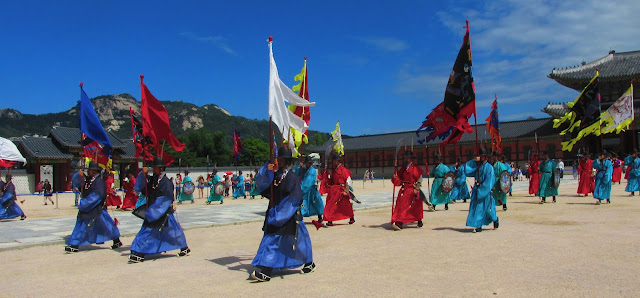Cheongnyangni Market
Looking for a place to get breakfast, I strolled through my hotel's neighborhood, and stumbled into a food market. Though Cheongnyangni (so difficult to read let alone pronounce) isn't an area that draws many tourists, the food market certainly was interesting and, I feel, representative of Asia in so many ways that Tokyo isn't, with Japan's capital's most similar counterpart probably being Ameyayokocho.
The dirt roads, pungent smells and otherworldly foods provided an ambiance I hadn't seen since I was in the Amazon villages of Peru.
Literally five minutes before starting to write this post, I found out that this market was one of the two things Cheongnyangni is known for. The other is for being one of the last surviving red light districts in Seoul. Go figure!
Gyeongbokgung Palace
After eventually getting breakfast, I had a cab drop me off right in front of what was Seoul's greatest historical monument - the Gyeongbokgung Palace grounds. Located at the northern edge of the city, the palace had all the magnificence of the Todaiji Temple in Nara, only with three times the amount of space. Whereas most castles in Japan have maintained only their central keeps and a few towers along their walls, Gyeongbokgung's palace grounds are immensely full and complete with pavilions, pond, garden, barracks, living quarters, courtyards and pagodas. It seemed like it would take forever to circumnavigate the whole thing, and much more likely that my legs would give out before I was done.
But what gave Gyeongbokgung its magnificence was not simply its enormity, but the presence of mountains in its direct vicinity, providing a backdrop that I wasn't expecting to find in Seoul at all. As I had stated before, Seoul itself is surrounded by a ring of mountains, but for that to be visible in such an obvious way was quite a treat indeed.
That, and I had actually made it to the palace just in time for the changing of the guards ceremony! Several times a day, the guards of Gyeongbokgung (which retain a ceremonial purpose rather than an actual practical one) relieve each other from their duties. Dressed in colorful attire, they parade the palace grounds as they do so, playing a great variety of antiquated instruments that come together in harmonious cacophony (if that makes sense at all.) As the guards are changed, the captain inspects each one's weapons - their great poleaxes and the short bows fashioned to their shoulders, before sending them off to the barracks. It's a great show and it made me more than just a little giddy. Also, you can pose with the guards!
Gwanghwamun Square
Right in front of the palace is the Gwanghwamun Square, which is more of an elongated rectangle featuring the statues of both the Admiral Yi Sun-sin, and King Sejong the Great (pictured), the latter who took part in the invention of the Hangul alphabet used in modern Korea. The square is pretty modern now and serves as a really hip spot you could probably take a date to. Since I happened to go on a sunny day, some dozen pianos were laid out in the open, for any passerby to play if they fancied.
Though I wouldn't say the place was quite busy in any sense of the word, there certainly were a few couples and families walking around and trying their hand at it.
Actually, corny as it might seem, there was a nearby booth open which allowed people to try on hanboks, which are the Korean equivalent of the kimono, for free, and pose against a replica of the same great painting located inside the actual Gyeongbokgung Palace. Trying a hanbok on happened to be on my to-do list, so I gladly obliged and dressed up pretty regally (I assume.)
That about sums up the best parts of my trip! To be sure, I also visited Tapgol Park, where the Koreans declared independence from Japan, and walked along a short section of the Chronggyecheon river, famous for its lantern festivals, before returning to Myeong-dong and eventually to the airport. I'm sure there's someone like me who's traveled from Canada to Korea rather than Japan and has been keeping a blog for over three years about the hundreds of things you can do in Korea, but my own trip was short and sweet. I came back home with about 5,500 Won left in my wallet (which is roughly 5,50$) plus a stomachache from eating too much spicy food, but moreover I know a little more about South Korea, which is nice.
What would I have done with a little more time? Visit the DMZ of course! Otherwise known as the North Korean border. Some day, eh?








No comments:
Post a Comment